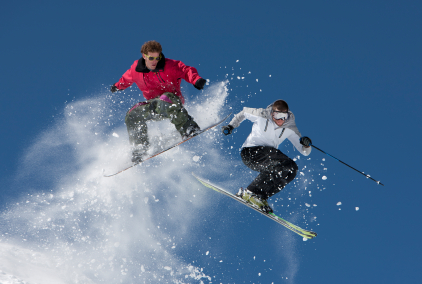 Every guy knows that the winter months mean many things, and one of those things is weight gain. Since it’s often hard to jog or even get to the gym in the face of a serious snowfall, exercise too frequently takes a backseat to the rest of your life as the cold deepens. We tend to eat heartier and more during the cold months, as our metabolisms slow in an evolutionary directive to preserve the layer of fat our ancestors spent all summer laying in against the lean, cold months. So, especially when this biological impetus is combined with the unbridled gluttony of the holiday season, we find ourselves buckling our belts a bit looser and sucking in the chubbier gut. We make our New Year’s resolutions to lose all that winter weight–but what if you could keep the pounds off altogether? Here are some tips for keeping the extra weight off during the winter with outdoor sports.
Every guy knows that the winter months mean many things, and one of those things is weight gain. Since it’s often hard to jog or even get to the gym in the face of a serious snowfall, exercise too frequently takes a backseat to the rest of your life as the cold deepens. We tend to eat heartier and more during the cold months, as our metabolisms slow in an evolutionary directive to preserve the layer of fat our ancestors spent all summer laying in against the lean, cold months. So, especially when this biological impetus is combined with the unbridled gluttony of the holiday season, we find ourselves buckling our belts a bit looser and sucking in the chubbier gut. We make our New Year’s resolutions to lose all that winter weight–but what if you could keep the pounds off altogether? Here are some tips for keeping the extra weight off during the winter with outdoor sports.
The Benefits of Winter Sports
According to the American College of Sports Medicine, the chronic boredom of being stuck inside during the winter often inspires people to eat more. Additionally, the lack of sunlight can cause a type of seasonal depression called Seasonal Affective Disorder, which causes brain chemistry alterations that produce cravings for starchy, sugary foods—carbohydrates, the energy-filled powerhouses that are more readily turned into stored fat by the body than protein. However, by getting outside and into the sun (or at least natural light), you will find that SAD dissipates. Exposure to fresh air and sunshine, even in the chilly cold, is a great antidote for this disorder. Packing on winter sports gear such as skis, snowshoes, and backpacks turns your entire workout up a notch in terms of intensity, helping you to burn more calories.
Snowshoeing
Snowshoeing is very user-friendly, since the equipment is minimal as far as financial investment in equipment and necessary skill. Most trails are free! Snowshoeing burns 600 calories or more per hour, making it one of the best aerobic exercises out there. There are two main kinds of snowshoes: recreational hiking snowshoes, which are right for novices. They work well on easier terrain that doesn’t have a lot of steep descents. There are aerobic snowshoes for those who are more skilled and also for those who want to run. For deep powder snow, try hiking and backpacking snowshoes.
Cross Country Skiing
All the fantastic ski resorts capitalize on terrain that needs lifts to traverse, allowing Alpine or downhill skiers to ascend the peaks and zip down manicured slopes. However, this isn’t the only kind of skiing! Nordic or cross-country skiing pits man against unspoiled nature, hills and all, without the aid of a lift. This is also a major aerobic exercise, with calorie-burning capabilities between 500-800 calories per hour. Plus, it’s a great way to gain coordination, strength, and is a wonderful way to gain a sense of independence and enjoy the great outdoors.
Downhill Skiing
Not to be forgotten, downhill or Alpine skiing burns between 300-600 calories per hour, according to the Mayo Clinic. This estimation is very approximate, though, since how many calories burned varies according to the skiing venue. For instance, the Whistler/Blackcomb resort in BC has steep top-to-bottom trails that take almost an hour to finish, while other resorts have lifts running the entire slope. Mogul skiing requires a greater amount of exertion, as well as back country skiing, where you have to hike up the mountain and ski down an un-groomed, challenging slope. Alpine skiing also uses heavier ski equipment, increasing its intensity.

